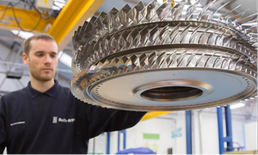Variability in high pressure blade trailing edge geometry and its impact on stage capacity and blade temperature
- Homepage
- http://ngcm.soton.ac.uk/projects/Variability-in-high-pressure-blade-trailing-edge-geometry-and-its-impact-on-stage-capacity-and-blade-temperature.html
- Started
- 22nd September 2014
- Research Team
- Jan Kamenik
- Investigators
- Andy Keane
Since turbine blades are film and internally cooled, any alterations in flow conditions can have significant impact on HP turbine passage capacity, blade temperatures and hence blade life.
It had been assumed that the minimum 'geometrical' throat was the key driver in determining capacity but it has now been demonstrated that the Mach=1 surface forms on the TE coolant and the suction surface, which is significantly downstream of the TE. Furthermore, this coolant flow itself, i.e. the jet, can vary because of the inner lip angle (due to manufacturing variability) and a small change in this angle causes a large change in capacity settings.
In my PhD project data from the blade manufacturing process and experimental rigs will be combined with high fidelity RANS based CFD studies to investigate the impact of manufacturing variability on flow and temperature conditions from a multi-objective standpoint. The work will be based on the existing suite of proprietary tools employed by Rolls-Royce to model their blade flows and temperature profiles (Padram / Hydra / SC03) combined with Siemens NX geometry models to hold the stochastic information on geometric variations.
This research is partly funded by the EPSRC and Rolls-Royce plc.
Project Information:
Project Ref: NGCM-0025 Supervisor: Andy Keane Co-supervisor: David Toal Faculty: FEE Academic Unit: AACE Research Group: CED Research Area: Computational Engineering
Categories
Physical Systems and Engineering simulation: CFD, Heat transfer, Turbulence
Algorithms and computational methods: Finite volume, Optimisation, statistical analysis
Transdisciplinary tags: NGCM
